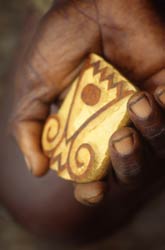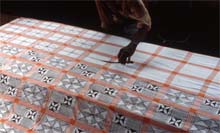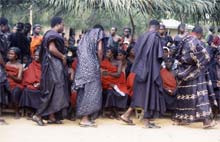 |
|
The Asante peoples of Ghana use adinkra to express the connection between the verbal and the visual in Akan culture. Adinkra symbols appear on wooden prestige objects, jewelry, brass weights and, most prominently, as two-dimensional stamped designs ornamenting cloth. Historically, adinkra was reserved for Asante kings. Over the years, however, its use has expanded to the general Akan population who wear adinkra cloth on significant occasions, the most important of which are funerals.
Of the hundreds of adinkra signs and meanings that have been documented, the older symbols are most often linked to proverbs, folktales, folksongs and popular sayings. Newer designs are associated with more common themes, such as flora, fauna and everyday objects, or may demonstrate literacy of the alphabet through designs composed of letters in Roman script that spell out personal names or segments of proverbial expressions. Mastering the nuances of this graphic form of communication is usually only accomplished by well-trained artists and elders who, through study, are able to identify the names of many adinkra symbols, the proverbs associated with them and the situations best addressed through particular symbols.
|

Stamp carver Joseph Nsiah of Ntonso, Ghana, holding an adinkra stamp
1988.
Photo and caption information by Dan Mato,
Professor Emeritus of Art History, The University of Calgary
One of the best known adinkra stamp carvers in Ghana, Mr. Nsiah carved this stamp out of a section of gourd. The image/symbol is identified with the proverb: "Aka mani na mede hwe wo" - "I have just to watch you with my eyes," meaning one can observe a fool and their actions and know the outcome.
|

A cloth decorator working in Ntonso, Ghana
1988
Photo and caption information by Dan Mato,
Professor Emeritus of Art History, The University of Calgary
This artist stamps and decorates cloth working on a long board that has cocoa mats underneath to soak up the dye and provide a working surface. He lays out the squares and alternates the motif enclosed within each square. His is a unique style in that he uses a comb with two 'teeth' to draw the designs as squares and triangles. Others use carved stamps to produce the same design.
The bold cross motif is called "Musuyide" and is a talisman to prevent evil. Its heritage is traced to Islamic metal patterning from the north, a predominantly Muslim region of the country. This motif has also been associated with the proverb: "Kerapa te se okera, okyiri fi" - "Sanctity, like a cat, abhors filth," meaning, one must lead a good/clean life to be a decent person. The opposed triangles are known as "Mframandam" - "Wind House," a reference that suggests an airy, well-ventilated house, a metaphor for the readiness to face life's changing circumstances.
|

Visitors at an important funeral at Assamang, Ghana,
1994.
Photo and caption information by Dan Mato,
Professor Emeritus of Art History, The University of Calgary
In this image, men wearing adinrka cloth greet seated women of the abusua, the matrilineage. The dark cloth worn by the man in the center is factory stamped. He is flanked by men wearing traditional biris cloth. These dark blue-black cloths are stamped with the very dark brown, nearly black adinkra with traditional adinkra motifs
|

Cloth wrapper (adinkra) belonging to King Prempeh I. Asante peoples,
Ghana,
ca. 1896.
Imported cotton cloth, black pigment.
210.8 x 302.3 cm.
Museum purchase. National Museum of African Art,
83-3-8.
Photograph by Franko Khoury

|
|

|








